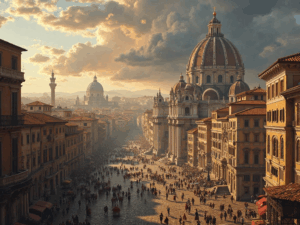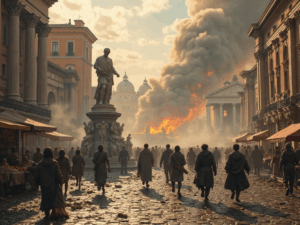History is full of moments that seem almost too catastrophic to bear, yet in their aftermath lie the seeds of rebirth, innovation, and transformation. On May 6, 1527, one such moment unfolded in the heart of one of the world’s greatest cities—Rome. Known as the Sack of Rome, this event forever altered the trajectory of a city celebrated for its artistic and cultural brilliance and marked a turning point in the political and religious landscape of Europe. In this blog, we will journey through the dramatic events of that fateful day, explore the profound consequences of destruction, and draw parallels that reveal how even the most devastating setbacks can serve as catalysts for personal growth and new beginnings in our lives.
## I. A Glimpse into an Unimaginable Catastrophe
### The Setting
In the early 16th century, Rome was not merely the seat of the Papacy but also the epicenter of the Renaissance—a period of explosive creativity, intellectual exploration, and artistic mastery. The city’s cobblestone streets echoed with the footsteps of scholars, artists, and dignitaries. Magnificent churches, palaces, and public spaces bore the testament of human creativity in marble, frescoes, and intricate sculpture. Yet beneath this splendor, political tensions simmered, alliances shifted, and a tempest of ambition and betrayal grew with each passing day.
### The Invasion Unfolds
On May 6, 1527, the unthinkable happened. An army composed predominantly of mutinous German Landsknechts, emboldened by the promise of plunder and further fueled by factions from Spain and Italy, descended upon the eternal city. What began as an advancing force quickly transformed into a merciless horde. The invaders swept through Rome’s narrow streets, toppling statues and desecrating churches, leaving chaos and ruin in their wake. Markets were ransacked, once-hallowed sanctuaries were defiled, and families found themselves uprooted in the face of an overwhelming force that spared neither nobility nor pauper.
For the citizens of Rome, the horror was complete. Buildings that had once stood as monuments to human achievement were reduced to rubble, and the vibrant fabric of daily life unraveled in an instant. In a single day, centuries of art, culture, and tradition were violently upended. While many historical accounts recount the grisly details of this event—the screams, the desperate pleas, the sense of profound loss—what resonates through the centuries is not merely the devastation but the resilience that emerged from its remnants.
### The End of an Era and the Dawn of Something New
The Sack of Rome had far-reaching consequences. It is often regarded as one of the decisive moments marking the end of the High Renaissance in the city. As the invaders passed through, they not only looted and burned but also inadvertently sowed the seeds of transformation. With the fall of Rome’s old order, the resulting power vacuum and cultural disillusionment set the stage for new forms of artistic expression, alternative political ideas, and renewed religious introspection. In the chaos, ideas were liberated from their traditional confines—a painful yet necessary prelude to innovation and reinvention.
## II. The Aftermath: Ruin as a Catalyst for Renewal
### Destruction That Opens the Door to Transformation
When we examine the Sack of Rome, it is tempting to dwell solely on the chaos and heartbreak. Yet, history teaches us that from profound destruction often emerges a powerful need to rebuild, reimagine, and innovate. In the ruins left by the invaders, fragments of Rome’s past caught the light of a new day. Some survivors gathered their most cherished works of art, manuscripts, and relics, desperate to preserve the heritage that the sack had sought to erase. In those hallowed embers of devastation, the citizens found not only the sorrow of what was lost but also the inspiration to rise again.
The end of an era does not mark a complete halt to creativity; rather, it can compel a society to reforge its identity. In the case of Rome, while the sack brought about immediate pain and disarray, it simultaneously challenged the established order—demanding that artists, architects, and intellectuals look beyond the old templates. Over time, this led to new innovations, a reawakening of artistic freedom, and eventually a cultural rebirth that had far-reaching implications for Europe as a whole.
### Lessons from a City Reborn
Beyond the literal rebuilding of physical structures, the true triumph following the sack was the human spirit’s ability to regenerate. The story of Rome after May 6, 1527, is not solely one of loss; it is also a testament to resilience, underscored by a commitment to preserve and innovate. Individuals who experienced the devastation firsthand had no choice but to reconfigure their lives, their work, and their very identities. Painful though it was, the tragedy triggered profound introspection and nurtured a fertile ground for new thinking.
Artists changed their techniques, infusing raw emotion into their work to capture the essence of human suffering and hope. Thinkers and philosophers questioned long-held doctrines, paving the way for more secular and introspective worldviews. In business and governance, the collapse of the old order opened avenues for novel power structures and economic models that were more adaptable to the rapidly changing world. The sack of Rome reminds us that even in our darkest moments, the chance for rebirth is always present.
## III. Drawing Parallels: Personal Hardship as a Moment of Transformation
### Personal Catastrophes and the Search for Renewal
While the sack of a great city like Rome may seem worlds apart from our personal experiences, the underlying themes are profoundly universal. Many of us face moments that feel as though our entire world has been upended—loss of a job, the end of a significant relationship, or a sudden health crisis. In such moments, the feelings of despair, vulnerability, and disorientation can mirror what the citizens of Rome experienced on that fateful May day.
Consider the experience of waking up one morning, only to find that everything you’ve built has been shattered by circumstances beyond your control. Much like Rome, your carefully constructed world might seem to crumble before your eyes. Whether you face professional setbacks or personal tragedies, the pain of loss can be overwhelming. However, by examining the aftermath of historical disasters such as the Sack of Rome, we can learn a vital lesson: destruction, as heartbreaking as it is, is not the end but the beginning of a transformative journey.
### Finding Strength in Vulnerability
The inhabitants of Rome were forced to confront their vulnerability head-on. They had to come to terms with a reality where nothing was guaranteed—a hard truth that, although excruciating, ultimately contributed to a deeper, more authentic understanding of life. In our own lives, there are moments when vulnerability can feel like a threat; however, it is precisely through this openness to pain that true change can occur.
When you allow yourself to acknowledge and sit with your grief and difficulties, you create the space for healing and innovation. This process of rebuilding—whether it involves mending relationships, reinventing your career, or rediscovering your passions—mirrors the way many Romans eventually gathered the pieces of their shattered city and worked to reconstruct something new and resilient. Just as the ruins of ancient Rome eventually gave way to new architectural marvels and cultural movements, so too can your personal setbacks open the door for renewal and growth.
### Embracing the Opportunity for Rebirth
History is filled with examples of societies and individuals who have emerged stronger from crises. It is in the act of rebuilding that creativity is born. When one door closes, another opportunity arises—often in a form that we may not have anticipated. The Sack of Rome, for instance, galvanized generations to challenge the status quo, to experiment with new artistic styles, and to explore radical ideas that would define the next ages of Western civilization.
In your own journey, moments of crisis should be seen not only as disruptions but as opportunities to reimagine and reconstruct your life. Instead of succumbing to despair, consider what these experiences might be urging you to change or reassess. Perhaps a loss inspires you to pursue a long-suppressed passion, to switch career paths, or to form deeper, more meaningful connections with those around you. The lesson here is unmistakable: within every ending lurks the potential for a new beginning, a chance to script a story that reflects your true self and deepest aspirations.
## IV. Practical Steps to Transform Your Life Through Adversity
It is one thing to acknowledge that hardship can lead to growth, and it is another altogether to take concrete steps to harness that potential. Below are some practical strategies inspired by the lessons of Rome’s past that can help you convert personal challenges into stepping stones for a brighter, more resilient future.
### 1. Embrace Change and Acknowledge Loss
Begin by recognizing that not all endings are final. Accept that what appears to be a devastating loss may be the precursor to transformative change. Allow yourself to experience the full gamut of your emotions—grief, anger, confusion—but do not let them paralyze you. Instead, use them as a signal that significant change is on the horizon.
**Action Step:**
Create a journal where you can freely express your emotions and document your journey. Write about what you’ve lost, what lessons you can extract from these experiences, and what possibilities might emerge from the ruins.
### 2. Cultivate Resilience Through Reflection
Historically, great transformations have been preceded by periods of deep introspection. Taking the time to reflect on your experiences, and observing how you have grown as a person, can anchor you and provide clarity. By reflecting on relative historical catastrophes like the Sack of Rome, you can frame your personal hardships as part of a larger narrative of resilience.
**Action Step:**
Spend time each day in quiet reflection or meditation. Consider using historical texts, biographies, or even documentaries about times of great change (like the Renaissance that followed Rome’s sack) to draw parallels with your own life. Allow the stories to inspire your own narrative of resilience.
### 3. Create a Vision for Rebuilding
Once you have processed your loss and have reflected on how it has changed you, start envisioning the life you want to rebuild. Just as the citizens of Rome gradually came together to forge a new future, you too can create a plan to rebuild your personal world. Define your priorities, set achievable goals, and craft a roadmap that aligns with your renewed sense of self.
**Action Step:**
Draft a “rebirth plan” that outlines the areas of your life you wish to transform—career, relationships, hobbies, health, and personal growth. Break down your goals into actionable steps; even small progress is a victory on the path to renewal.
### 4. Seek Support and Build Community
No one rebuilds alone. The aftermath of any great crisis is often alleviated by the support of a community. In the same way that remnants of Rome found solace and strength in each other as they began the long process of rebuilding their city, you can benefit from surrounding yourself with individuals who uplift and inspire you. Seek out mentors, friends, or groups that share your vision for change.
**Action Step:**
Identify people in your network who embody resilience and creativity. Join groups or communities—whether in person or online—that offer support tailored to your goals. Sharing your journey not only lightens the burden but also amplifies your ability to create lasting change.
### 5. Channel Creativity into New Ventures
Adversity often sparks creative expression. Many of the world’s most profound works of art, literature, and innovation have emerged from periods of great struggle and transformation. By channeling your emotions and experiences into a creative outlet, you not only process your loss but also give birth to something that can inspire others.
**Action Step:**
Choose a creative hobby or project that resonates with you, whether it’s writing, painting, photography, or even starting a blog. Allow your creative expression to narrate your journey of rebirth. This process can help redefine your identity and serve as an empowering reminder that you are capable of transforming pain into beauty.
### 6. Learn from the Past to Enrich Your Future
History is a profound teacher. The lessons drawn from events like the Sack of Rome are far more than academic—they are reflections of the human experience. By learning from the rise and fall of great civilizations, you can derive insights into the cyclical nature of challenges and growth. This perspective can help you see your own hardships as part of the grand tapestry of life, where every setback is a precursor to personal evolution.
**Action Step:**
Dedicate some time each week to studying historical events and their outcomes. Identify themes that resonate with you—resilience, innovation, the power of community—and reflect on how these themes apply to your journey. Use these insights to motivate your own transformation.
## V. The Enduring Legacy of Rebirth: A Call to Action
The Sack of Rome on May 6, 1527, stands as a stark reminder that even the most majestic societies are not immune to the ravages of time, conflict, and change. Yet, in its wake, profound lessons emerged—lessons about the impermanence of structures, the resilience of human spirit, and the capacity to transform devastation into a launchpad for growth. The citizens of Rome, faced with unspeakable loss, were eventually driven by a need to redefine themselves, innovate, and contribute to a renewed cultural legacy. Their collective response echoes through time and offers us a powerful lesson: from every ending, a new beginning can be forged.
In our modern lives, we too are no strangers to upheaval. Professional setbacks, personal losses, and unexpected crises may not compare in scale to the events of ancient Rome, but they can leave us feeling equally disoriented and broken. Yet, the story of Rome teaches us that it is precisely in these moments of vulnerability that the opportunity for rebirth is born. Much like a phoenix rising from the ashes, we can harness the energy of our hardships to ignite a transformation that is uniquely our own.
Take a moment to consider the challenges you face. What aspects of your life feel impossible to rebuild? Perhaps you feel that your career has stalled, a personal relationship has unraveled, or that self-doubt has taken root. These feelings, though painful, are the starting point of a journey. They are the catalyst for re-examining your values, discovering your inner strength, and crafting a future that is more aligned with your true self.
By applying the lessons of the past, you can begin to view each setback not as a dead end, but as an invitation to rebuild your life with renewed purpose. The process may be daunting, and the road to recovery may be long. However, every step you take—every decision to learn, to adapt, to create—is a victory, a step towards the renaissance of your own life. Embrace the chaos as a necessary part of the process. Understand that even in destruction, there is potential; even in loss, there is an opportunity to redefine who you are.
Let the memory of May 6, 1527, serve as a guiding beacon. While the events of that day were catastrophic for Rome, history shows us that the end of one era can be the fertile ground from which a new era emerges. Channel that same energy into your own life. Face your challenges head-on, let them fuel your creativity, and be open to the possibility that your most difficult moments may lead to your most significant breakthroughs.
## VI. Conclusion: Embracing Your Personal Renaissance
The road to rebuilding is never easy. It demands courage, relentless perseverance, and a willingness to embrace change—even when it feels overwhelming. The Sack of Rome is a poignant reminder that no state is permanent, no setback is insurmountable, and every moment of despair contains the potential for transformation. Just as Rome rose again, reshaped by the resolve of its people and the emergence of a new cultural panorama, you too have the capacity to sculpt a life replete with meaning, creativity, and achievement.
In your own life, challenges will come and go, but the choice to transform these challenges into stepping stones for growth lies squarely within your hands. Reflect on your past with honesty, learn from your failures, and be bold in pursuing a future that excites you. Remember: every crisis is an opportunity—it is the universe’s way of nudging you toward new horizons.
Today, as we remember the historic events of May 6, allow this day to also mark the beginning of a renewed personal journey. Rise from your own ashes with the knowledge that you are capable of profound reinvention. Draw inspiration from the past, build upon the lessons learned, and let your life become a testament to the enduring power of resilience and creativity.
May you find strength in adversity, let hope be your constant companion, and may your journey of transformation serve as a reminder to all that even in the wake of destruction, there is always the promise of renewal. Embrace your personal renaissance, and let the transformative lessons of history guide you to a future filled with infinite possibility.
By internalizing the timeless message of Rome’s revival, you unlock the potential to surmount every challenge that lies in your path. Every tear shed in despair, every loss experienced in the depths of adversity, is not an end but a prelude to extraordinary new beginnings. Today is the day to reimagine your destiny, to rise boldly and to craft a narrative where setbacks serve as the foundation for greatness.
In closing, take these words to heart: Your history is not written solely by your successes, but also by your struggles. Let your challenges illuminate your path, and let your resilience become the architecture of a life transformed. Just as Rome found its voice again after being silenced by force, so can you reclaim your power and rebuild your world—richer, wiser, and more luminous than before.
May this reflection of our past and its enduring lessons inspire you to look at every obstacle as the beginning of a new chapter. Embrace the challenges, learn from them, and know that within you lies the strength to rise again, to redefine your limits, and to create a future that gleams with the promise of fresh, transformative beginnings.

